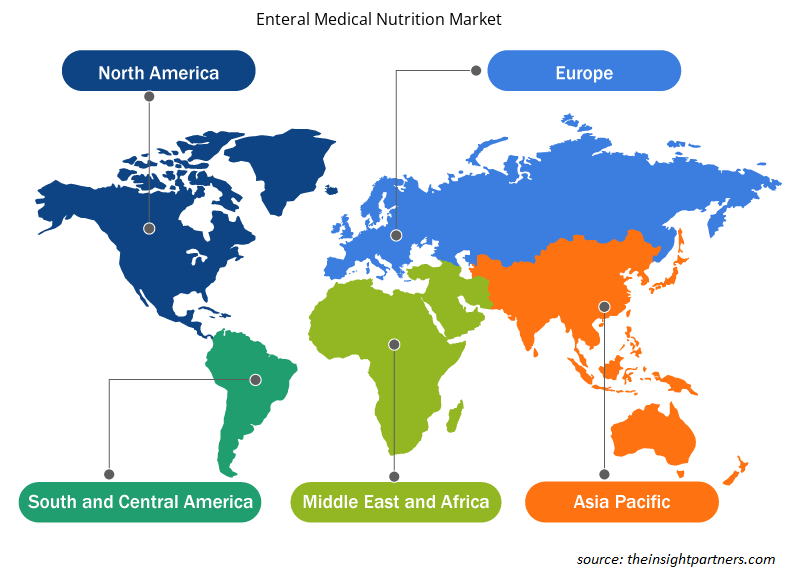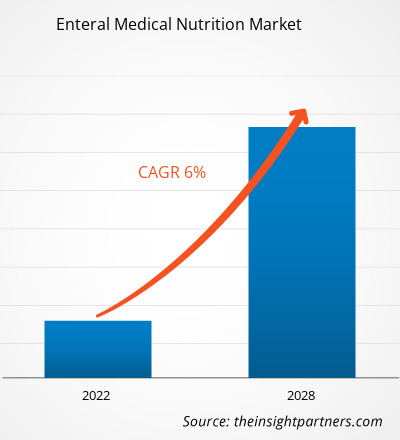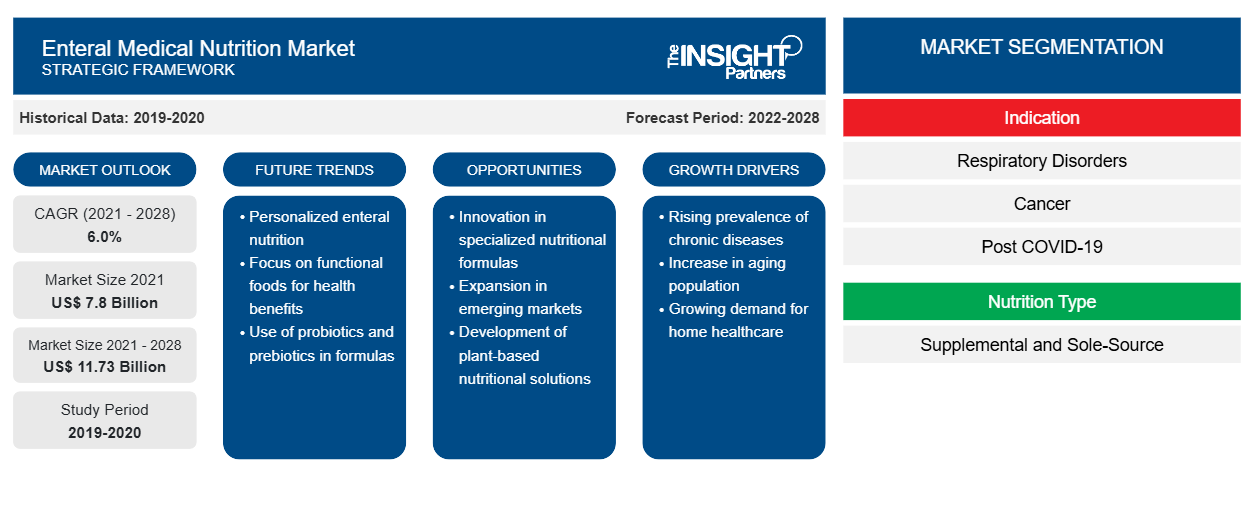Der Markt für enterale medizinische Ernährung soll von 7.803,45 Millionen US-Dollar im Jahr 2021 auf 11.726,37 Millionen US-Dollar im Jahr 2028 anwachsen; von 2022 bis 2028 wird ein durchschnittliches jährliches Wachstum von 6,0 % erwartet.
Eine enterale Ernährung (EN) wird Patienten verabreicht, deren Energie- und Nährstoffbedarf nicht durch eine normale Nahrungsaufnahme gedeckt werden kann. Die Vorteile der enteralen Ernährung gegenüber der parenteralen Ernährung sind allgemein anerkannt. Für die meisten pädiatrischen Patienten, die auf eine enterale Ernährung angewiesen sind, ist eine altersangepasste, mit Ballaststoffen angereicherte Standard-Polymernahrung eine geeignete Wahl.
Der Markt für enterale medizinische Ernährung ist nach Indikation, Ernährungsart, Form, Produkt, Vertriebskanal, Altersgruppe und Geografie segmentiert. Geografisch ist der Markt grob in Nordamerika, Europa, Asien-Pazifik, den Nahen Osten und Afrika sowie Süd- und Mittelamerika unterteilt. Der Bericht bietet Einblicke und eine eingehende Analyse des Marktes und betont Parameter wie Markttrends und Marktdynamik sowie die Wettbewerbsanalyse der weltweit führenden Marktteilnehmer.
Passen Sie diesen Bericht Ihren Anforderungen an
Sie erhalten kostenlose Anpassungen an jedem Bericht, einschließlich Teilen dieses Berichts oder einer Analyse auf Länderebene, eines Excel-Datenpakets sowie tolle Angebote und Rabatte für Start-ups und Universitäten.
-
Holen Sie sich die wichtigsten Markttrends aus diesem Bericht.Dieses KOSTENLOSE Beispiel umfasst eine Datenanalyse von Markttrends bis hin zu Schätzungen und Prognosen.
Markteinblicke
Zunahme der Prävalenz von Kachexie
Kachexie ist eine multifunktionale Erkrankung, die extremen Gewichtsverlust, Verlust von Skelettmuskulatur und Fettgewebe, Störungen der Stoffwechselregulation und eine verringerte Nahrungsaufnahme verursacht. Im fortgeschrittenen Stadium ist sie eine ernste klinische Folge fast aller chronischen Erkrankungen. Laut NCBI (National Center for Biotechnology Information) betrug die Kachexie- Prävalenz im Jahr 2016 bei Patienten mit chronischer Herzinsuffizienz im Endstadium 5 bis 15 %. Sie kommt häufig bei Patienten mit chronischer Nierenerkrankung, chronisch obstruktiver Lungenerkrankung ( COPD ) , neurologischen Erkrankungen und rheumatoider Arthritis vor . Die Sterblichkeitsrate von Kachexie- Patienten liegt bei 15 bis 25 % pro Jahr bei Patienten mit schwerer COPD und bei 20 bis 40 % pro Jahr bei Patienten mit chronischer Herzinsuffizienz oder chronischer Nierenerkrankung.
Krebskachexie beeinträchtigt die Lebensqualität von Krebspatienten, verringert die Wirksamkeit der Chemotherapie und erhöht ihre Toxizität, was zu einem Anstieg der krebsbedingten Sterblichkeit und des medizinischen Ressourcenaufwands führt. Laut Globocan meldete die Weltgesundheitsorganisation im Jahr 2018 9,6 Millionen Todesfälle und 18,1 Millionen neue Krebsfälle. Außerdem ist Krebskachexie ein Auszehrungssyndrom, das bei bis zu 80 % der Krebspatienten auftritt. Laut einem Artikel der Abteilung für Lungen- und Intensivmedizin in Peking beträgt die Prävalenz von Kachexie bei Patienten mit Bauchspeicheldrüsenkrebs und Magenkrebs 87 %, bei Patienten mit Dickdarm-, Lungen- und Prostatakrebs 61 % und bei Patienten mit Brustkrebs, Sarkomen , Leukämie und Hodgkin-Lymphom etwa 40 %. Zudem sind 20 % aller krebsbedingten Todesfälle auf Kachexie zurückzuführen . Bei Kachexie nimmt die Nährstoffversorgung des Körpers ab. Deshalb ist es notwendig, zur Fortsetzung der Behandlung von Krebs und COPD externe Nährstoffe bereitzustellen . Ärzte bevorzugen den enteralen Weg, um dem Patienten diese benötigten Nährstoffe zuzuführen. Daher treibt die zunehmende Verbreitung von Kachexie aufgrund der steigenden Inzidenz verschiedener chronischer Krankheiten das Wachstum des Marktes für enterale medizinische Ernährung voran.
Indikationseinblicke
Basierend auf der Indikation ist der Markt für enterale medizinische Ernährung in Atemwegserkrankungen, Krebs, Post-COVID-19, Magen-Darm-Erkrankungen, Leberversagen und andere unterteilt. Der Markt für das Segment Atemwegserkrankungen ist weiter segmentiert in chronisch obstruktive Lungenerkrankung ( COPD), Atemversagen, Mukoviszidose und andere. Der Markt für das Segment Krebs ist weiter segmentiert in Krebskachexie , Kachexie mit COPD und andere . Der Markt für das Segment Magen-Darm-Erkrankungen ist weiter segmentiert in Darmverschluss, Kurzdarmverschluss, Morbus Crohn und andere. Das Segment Atemwegserkrankungen hatte 2021 den größten Marktanteil. Es wird jedoch erwartet, dass das Segment Krebs im Prognosezeitraum die höchste durchschnittliche jährliche Wachstumsrate von 7,6 % auf dem Markt verzeichnet. Pulmocare von Abbott ist für Menschen konzipiert, die an COPD , Mukoviszidose oder Atemversagen leiden. Die kalorienreiche, modifizierte enterale Formel mit Kohlenhydraten und Fett kann diesen Patienten helfen, die ernährungsbedingte Kohlendioxidproduktion zu reduzieren.
Einblicke in den Ernährungstyp
Basierend auf der Art der Ernährung ist der globale Markt für enterale medizinische Ernährung in Nahrungsergänzungsmittel und Alleinnahrung unterteilt. Das Nahrungsergänzungssegment hatte 2021 einen größeren Marktanteil. Es wird jedoch erwartet, dass das Alleinnahrungssegment im Prognosezeitraum eine höhere CAGR verzeichnet. Die Patienten, die die Nahrungsergänzungsquelle erhalten, müssen für einen längeren Zeitraum im Krankenhaus bleiben. Den Patienten werden enterale Formeln verabreicht, die mit Omega-3-Fettsäuren, Ribonukleinsäuren und Glutamin oder Arginin angereichert sind. Jevity beispielsweise ist eine Ernährungsformel, die als Nahrungsergänzung oder Alleinnahrung für Erwachsene entwickelt wurde, die kurz- oder langfristig über eine Sonde ernährt werden. Sie ist in den Kaloriendichten 1,0, 1,2 und 1,5 Kalorien pro Milliliter erhältlich. Jevity-Formeln können auch dazu beitragen, den täglichen Protein- und Ballaststoffbedarf der Patienten zu decken.
Formulareinblicke
Basierend auf der Form ist der globale Markt für enterale medizinische Ernährung in Pulver, Flüssigkeit und halbfest unterteilt. Das halbfeste Segment hatte 2021 den größten Marktanteil und wird im Prognosezeitraum voraussichtlich die höchste durchschnittliche jährliche Wachstumsrate verzeichnen.
Produktinformationen
Basierend auf dem Produkt ist der globale Markt für enterale medizinische Ernährung in Standardproteindiäten, proteinreiche Diäten, orale Nährstoffe auf Fruchtsaftbasis und andere unterteilt. Das Segment der Standardproteindiäten hatte 2021 den größten Marktanteil. Es wird jedoch erwartet, dass das Segment der oralen Nährstoffe auf Fruchtsaftbasis im Prognosezeitraum die höchste durchschnittliche jährliche Wachstumsrate verzeichnet.
Einblicke in Vertriebskanäle
Basierend auf den Vertriebskanälen ist der Markt für enterale medizinische Ernährung in Krankenhausapotheken, Einzelhandelsgeschäfte und andere Apotheken unterteilt. Das Segment der Krankenhausapotheken hatte 2021 den größten Marktanteil. Es wird jedoch erwartet, dass das Segment der Einzelhandelsgeschäfte im Prognosezeitraum die höchste durchschnittliche jährliche Wachstumsrate verzeichnet.
Einblicke in die Altersgruppen
Basierend auf dem Alter ist der Markt für enterale medizinische Ernährung in Kinder (bis 18 Jahre) und Erwachsene (18+ Jahre ) unterteilt. Das Segment Erwachsene (18+ Jahre ) hatte im Jahr 2021 einen größeren Marktanteil. Es wird jedoch erwartet, dass das Segment Kinder (bis 18 Jahre) im Prognosezeitraum eine höhere durchschnittliche jährliche Wachstumsrate verzeichnet.
Regionale Einblicke in den Markt für enterale medizinische Ernährung
Die regionalen Trends und Faktoren, die den Markt für enterale medizinische Ernährung im Prognosezeitraum beeinflussen, wurden von den Analysten von Insight Partners ausführlich erläutert. In diesem Abschnitt werden auch die Marktsegmente und die Geografie für enterale medizinische Ernährung in Nordamerika, Europa, im asiatisch-pazifischen Raum, im Nahen Osten und Afrika sowie in Süd- und Mittelamerika erörtert.

- Erhalten Sie regionalspezifische Daten zum Markt für enterale medizinische Ernährung
Umfang des Marktberichts zur enteralen medizinischen Ernährung
| Berichtsattribut | Details |
|---|---|
| Marktgröße im Jahr 2021 | 7,8 Milliarden US-Dollar |
| Marktgröße bis 2028 | 11,73 Milliarden US-Dollar |
| Globale CAGR (2021 - 2028) | 6,0 % |
| Historische Daten | 2019-2020 |
| Prognosezeitraum | 2022–2028 |
| Abgedeckte Segmente |
Nach Indikation
|
| Abgedeckte Regionen und Länder |
Nordamerika
|
| Marktführer und wichtige Unternehmensprofile |
|
Dichte der Marktteilnehmer für enterale medizinische Ernährung: Auswirkungen auf die Geschäftsdynamik verstehen
Der Markt für enterale medizinische Ernährung wächst rasant. Dies wird durch die steigende Nachfrage der Endnutzer aufgrund von Faktoren wie sich entwickelnden Verbraucherpräferenzen, technologischen Fortschritten und einem größeren Bewusstsein für die Vorteile des Produkts vorangetrieben. Mit der steigenden Nachfrage erweitern Unternehmen ihr Angebot, entwickeln Innovationen, um die Bedürfnisse der Verbraucher zu erfüllen, und nutzen neue Trends, was das Marktwachstum weiter ankurbelt.
Die Marktteilnehmerdichte bezieht sich auf die Verteilung der Firmen oder Unternehmen, die in einem bestimmten Markt oder einer bestimmten Branche tätig sind. Sie gibt an, wie viele Wettbewerber (Marktteilnehmer) in einem bestimmten Marktraum im Verhältnis zu seiner Größe oder seinem gesamten Marktwert präsent sind.
Die wichtigsten Unternehmen auf dem Markt für enterale medizinische Ernährung sind:
- Abbott Laboratories
- Nutricia
- Fresenius Kabi AG
- B. Braun Melsungen AG
- NESTLE SA
Haftungsausschluss : Die oben aufgeführten Unternehmen sind nicht in einer bestimmten Reihenfolge aufgeführt.

- Überblick über die wichtigsten Akteure auf dem Markt für enterale medizinische Ernährung
Markt für enterale medizinische Ernährung – nach Regionen
Geografisch ist der globale Markt in Nordamerika (USA, Kanada und Mexiko), Europa (Großbritannien, Deutschland, Frankreich, Italien, Spanien und das übrige Europa), den asiatisch-pazifischen Raum (China, Japan, Indien, Australien, Südkorea und den übrigen asiatisch-pazifischen Raum), den Nahen Osten und Afrika (die Vereinigten Arabischen Emirate, Saudi-Arabien, Südafrika und den übrigen Nahen Osten und Afrika) sowie Süd- und Mittelamerika (Brasilien, Argentinien und den übrigen Süd- und Mittelamerika) unterteilt.
Firmenprofile
Zu den Hauptakteuren auf dem Markt für enterale medizinische Ernährung zählen Abbott Laboratories, Nutricia, Fresenius Kabi AG, B. Braun Melsungen AG, NESTLE SA, Meiji Holdings Co., Ltd., Smartfish AS, DSM, Hormel Foods Corporation und Global Health Products, Inc.
- Historische Analyse (2 Jahre), Basisjahr, Prognose (7 Jahre) mit CAGR
- PEST- und SWOT-Analyse
- Marktgröße Wert/Volumen – Global, Regional, Land
- Branchen- und Wettbewerbslandschaft
- Excel-Datensatz
Aktuelle Berichte
Verwandte Berichte
Erfahrungsberichte
Grund zum Kauf
- Fundierte Entscheidungsfindung
- Marktdynamik verstehen
- Wettbewerbsanalyse
- Kundeneinblicke
- Marktprognosen
- Risikominimierung
- Strategische Planung
- Investitionsbegründung
- Identifizierung neuer Märkte
- Verbesserung von Marketingstrategien
- Steigerung der Betriebseffizienz
- Anpassung an regulatorische Trends























 Kostenlose Probe anfordern für - Markt für enterale medizinische Ernährung
Kostenlose Probe anfordern für - Markt für enterale medizinische Ernährung